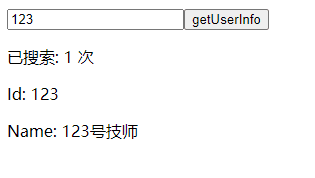Ecosyste.ms: Awesome
An open API service indexing awesome lists of open source software.
https://github.com/haixiangyan/my-redux-thunk
手把手实现一个 redux-thunk 中间件
https://github.com/haixiangyan/my-redux-thunk
reactjs redux redux-thunk thunk-middleware
Last synced: about 1 month ago
JSON representation
手把手实现一个 redux-thunk 中间件
- Host: GitHub
- URL: https://github.com/haixiangyan/my-redux-thunk
- Owner: haixiangyan
- License: mit
- Created: 2021-04-21T15:16:52.000Z (almost 4 years ago)
- Default Branch: main
- Last Pushed: 2021-04-28T05:03:06.000Z (over 3 years ago)
- Last Synced: 2024-10-25T02:48:24.498Z (3 months ago)
- Topics: reactjs, redux, redux-thunk, thunk-middleware
- Language: JavaScript
- Homepage: https://yanhaixiang.com/my-redux-thunk/
- Size: 349 KB
- Stars: 5
- Watchers: 2
- Forks: 1
- Open Issues: 0
-
Metadata Files:
- Readme: README.md
- License: LICENSE
Awesome Lists containing this project
README
# 造一个 redux-thunk 轮子

[](https://www.travis-ci.com/Haixiang6123/my-redux-thunk)
> 文章源码: https://github.com/Haixiang6123/my-redux-thunk
>
> 参考轮子: https://www.npmjs.com/package/redux-thunk
哈?redux-thunk 不就是那个只有 14 行代码的轮子嘛?我一行就能写出来还要你来教我做事?
不错,redux-thunk 是一个非常小的库,不到 5 分钟就能理解并造出来。但是今天我并不想从 “怎么造” 这个角度来讲这个轮子,而是想从 “为什么” 这个角度来聊一聊这个轮子的是怎么出现的。
很多分析 redux-thunk 源码的文章一般会说:如果 action 是函数的话就传入 dispatch,在 action 函数里面使用 `dispatch`,如果action 不是函数的话就正常 `dispatch(action)`。不过,我觉得这是从结果出发找造这个轮子的原因,并不能从需求层面解释这个中间件到底解决了什么问题。
本文希望从解决问题的角度来推导 redux-thunk 诞生的原因。
## 一个需求
首先,我们先把 redux-thunk 忘了,来看一下这个需求:
1. 输入框搜索用户 Id,调用 getUserInfoById 来获取用户信息
2. 展示对应用户 id 和 name

首先,我们弄一个 store 存放 `userInfo`。
```jsx
// store.js
const initState = {
userInfo: {
id: 0,
name: '0号技师',
}
}
const reducer = (state = initState, action) => {
switch (action.type) {
case 'SET_USER':
return {...state, userInfo: action.payload} // 直接更新 userInfo
default:
return state
}
}
const store = createStore(reducer, initState)
```
然后使用 **react-redux** 提供的 `Provider` 向整个 App 注入数据:
```jsx
// App.jsx
function App() {
return (
)
}
```
最后一步,在 `UserInfo` 组件里获取并展示用户信息。
```js
// UserInfo.jsx
const UserInfo = () => {
const dispatch = useDispatch()
const userInfo = useSelector(state => state.userInfo)
// 业务组件状态
const [loading, setLoading] = useState(false)
const [id, setId] = useState('')
// 根据 Id 获取 userInfo
const fetchUserById = (id) => {
if (loading) return
return new Promise(resolve => {
setLoading(true)
setTimeout(() => {
const newUserInfo = {
id: id,
name: id + '号技师'
}
dispatch({type: 'SET_USER', payload: newUserInfo})
setLoading(false)
resolve(newUserInfo)
}, 1000)
})
}
return (
setId(e.target.value)}/>
fetchUserById(id)}>getUserInfo
{
loading ?
加载中... : (
Id: {userInfo.id}
Name: {userInfo.name}
)
}
)
}
```
上面代码很简单:在 `input` 输入 id 号,点击“getUserInfo”按钮后触发 `fetchUserById`,1 秒后拿到最新的 `userInfo` 来更新 store 值,最后展示技师信息。
## 解耦
上面的代码在很多业务里非常常见,常见到我们根本不需要什么 redux-thunk,redux-saga 来处理。不就是 fetch 数据,把数据放到 `action.payload`,再 dispatch 这个 action 更新值嘛。所以很多人看到这些“框架”的时候都会觉得很奇怪:这些库好像解决了一些问题,但好像又感觉没做什么大事情。
这么写有什么问题呢?**假如我想把 `fetchUserById` 抽到组件外面就很痛苦了,因为整个 `fetchUserById` 完全依赖了 `dispatch` 函数。** 有人可能会说了,我直接外层 import `store.dispatch` 来使用不就解除依赖了么:
```js
// store 一定为单例
import store from './store'
const fetchUserById = (id) => {
if (loading) return
return new Promise(resolve => {
setTimeout(() => {
const newUserInfo = {
id: id,
name: id + '号技师'
}
store.dispatch({type: 'SET_USER', payload: newUserInfo})
resolve(newUserInfo)
}, 1000)
})
}
```
**但是这样会导致你的 store 必须是一个单例!单例就不好了么?某些情况下如 SSR,mock store,测试 store 就需要同时存在多个 store 的情况。所以,单例 store 是不太推荐的。**
**另一个解耦方法:我们可以把 `dispatch` 作为参数传入,而不是直接使用,这样就可以完成函数的解耦了:**
```js
// 根据 Id 获取 userInfo
const fetchUserById = (dispatch, id) => {
if (loading) return
return new Promise(resolve => {
setTimeout(() => {
const newUserInfo = {
id: id,
name: id + '号技师'
}
dispatch({type: 'SET_USER', payload: newUserInfo})
resolve(newUserInfo)
}, 1000)
})
}
// UserInfo.jsx
const UserInfo = (props) => {
const dispatch = useDispatch()
const {userInfo, count} = useSelector(state => state)
const [loading, setLoading] = useState(false)
const [id, setId] = useState('')
const onClick = async () => {
setLoading(true)
await fetchUserById(id, dispatch)
setLoading(false)
}
return (
...
)
}
```
虽然上面的 `fetchUserById` 看起来还是有点智障,但是只在使用的时候才传入 dispatch,完全脱离了 dispatch 的依赖。
## 柯里化
每次执行 `fetchUserById` 都要传一个 `dispatch` 进去,这不禁让我们想到:能不能先在一个地方把 `fetchUserById` 初始化好,比如初始化成 `fetchUserByIdWithDispatch`,让它拥有了 `dispatch` 的能力,然后执行的时候直接使用 `fetchUserByIdWithDispatch` 函数呢?
**使用闭包就解决了(也可以说将函数柯里化),所谓的柯里化也仅是多返回一个函数:**
```js
// 根据 Id 获取 userInfo
const fetchUserById = (dispatch) => (id) => {
return new Promise(resolve => {
setTimeout(() => {
const newUserInfo = {
id: id,
name: id + '号技师'
}
dispatch({type: 'SET_USER', payload: newUserInfo})
resolve(newUserInfo)
}, 1000)
})
}
```
使用的时候把 `dispatch` 传入生成新函数,相当于给 `fetchUserById` **“赋能”**:
```jsx
// UserInfo.jsx
const UserInfo = () => {
const dispatch = useDispatch()
const {userInfo, count} = useSelector(state => state)
const [loading, setLoading] = useState(false)
const [id, setId] = useState('')
const fetchUserByIdWithDispatch = fetchUserById(dispatch)
const onClick = async () => {
setLoading(true)
await fetchUserByIdWithDispatch(id)
setLoading(false)
}
return (
...
)
}
```
定义的 `fetchUserById` 有点类似工厂模式里的工厂函数,由其生成的 `fetchUserByIdWithDispatch` 才是我们真实想要的 “fetchUserById”。
这样的 **“函数式套娃”** 在 redux 的很多轮子中都出现过,对造轮子有很大作用,希望大家可以对此有个印象。我自己对这样处理一个形象的理解是:好比一个正在准备发射的火箭,每执行一次外层的函数时就像给这个火箭加一点能量,等执行到最后一个函数的时候整个火箭就以最快的速度喷射出去。
回到例子,这样的函数声明方式也不好,每次使用的时候都要用 dispatch 初始化一下,还是很麻烦。而且容易给人造成误解:好好的 `fetchUserById` 不传 id 而是传一个 `dispatch` 函数来初始化。怕是会顺着网线过来锤你。
## 把参数互换位置
我们理想中的 `fetchUserById` 应该是像这样使用的:
```
fetchUserById(id)
```
**把 dispatch 和 id 尝试换一下看看效果如何:**
```js
// 根据 Id 获取 userInfo
const fetchUserById = (id) => (dispatch) => {
return new Promise(resolve => {
setTimeout(() => {
const newUserInfo = {
id: id,
name: id + '号技师'
}
dispatch({type: 'SET_USER', payload: newUserInfo})
resolve(newUserInfo)
}, 1000)
})
}
```
组件里的 onClick 就要这样使用了:
```js
const onClick = async () => {
setLoading(true)
const fetchDispatch = fetchUserById(id)
await fetchDispatch(dispatch)
setLoading(false)
}
```
虽然表面上可以 `fetchUserById(id)` 了,但是 `fetchDispatch(dispatch)` 也太丑了了。**能不能把 “fetchUserById” 和 “dispatch” 反过来写呢**,变成这样:
```js
dispatch(fetchUserById(id))
```
这样一来,所以用到 `dispatch` 的代码都可以用下面这样的函数来封装了:
```js
const fn = (...我的参数) => (dispatch) => {
// 用“我的参数”做一些事...
doSomthing(我的参数)
// dispatch 修改值
dispatch(...)
}
```
**为了下次懒得再一次解释这样的函数结构,干脆用一个词这概括它,就叫它 "thunk" 吧。**
要实现上面的效果,我们需要更改 `dispatch` 函数内容,使其变成增强版的 `dispatch`:入参为函数时执行该函数的返回函数,同时传入 `dispatch`,如果为普通 action 时直接 `dispatch(action)`。
```js
const originalDispatch = store.dispatch
const getState = store.getState
store.dispatch = (action) => {
if (typeof action === 'function') {
action(originalDispatch, getState)
} else {
originalDispatch(action)
}
}
```
直接赋值来增强 `dispatch` 是不太雅观的,更优雅的方式是用 redux 提供了中间件的功能来增强 `dispatch` 函数。
## 中间件
可能很多人还不会写 redux 的中间件。其实非常简单,都是有套路的。首先,弄一个模板出来:
```js
const thunkMiddleware = ({dispatch, getState}) => (next) => (action) => {
next(action) // 交给下一个中间件处理
}
```
上面相当于一个啥也不做的 "Hello World" 版中间件,然后根据我们刚刚的思路做出基础版 redux-thunk 中间件:
```js
const thunkMiddleware = ({dispatch, getState}) => (next) => (action) => {
if (typeof action === 'function') {
action(dispatch, getState) // 如果是函数,执行该函数
} else {
next(action) // 交给下一个中间件处理
}
}
```
然后在 store.js 里用 `applyMiddleware` 加入中间件:
```js
// store.js
const store = createStore(reducer, initState, applyMiddleware(thunkMiddleware))
```
刷新页面会发现在执行 `onClick` 的时候,会发现根本没有 loading!
```js
const onClick = async () => {
setLoading(true)
await dispatch(fetchUserById(id))
setLoading(false)
}
```
这是因为 `fetchUserById` 返回是个 Promise,而中间件里没有把它 return 出去,所以 `setLoading(false)` 并没有等 `await dispatch(fetchUserById(id))` 的 Promise 回来就执行了。
为了解决这个问题,只需在中间件里加一句 `return` 就好,并简化一下代码:
```js
const thunkMiddleware = ({dispatch, getState}) => (next) => (action) => {
if (typeof action === 'function') {
return action(dispatch, getState)
}
return next(action)
}
```
可能有人会觉得 `action(dispatch, getState)` 里为什么不传 `next` 函数,而是传入 `dispatch` 函数呢?毕竟 next 到最后就是 `dispatch` 了呀,这里就不得不做 `next` 和 `dispatch` 这两个函数的执行意义了:

* store.dispatch,也就是我们经常用到的 dispatch 函数,其实是通过所有中间件增强后的 dispatch,可以理解为 `completelyEnhancedDispatch`
* next,函数签名也是 `(action) => action`,但是这是在走中间件时的函数,有点像增强到一半的 dispatch,可以理解为 `partiallyEnhancedDispatch`
对比如下:
| 函数 | 类型 | 增强程度 | 执行流程 | 意义 |
|---|---|---|---|---|
| dispatch | `(action) => action` | 完全增强 | 走完整个中间件流程,在最后调用原始的 `dispatch(action)` | 开始整个分发的流程 |
| next | `(action) => action` | 半增强 | next 前为进入中间件部分,next 后为返回中间件部分 | 交给下一个中间件处理 |
**在 `fetchUserById` 函数里的 `dispatch` 的工作是要分发 action,要这个 action 是要走完所有中间件流程的,而不是传给下一个中间件处理,所以中间件里传入的参数为 `dispatch` 函数而不是 `next` 函数。**
## withExtraArgs
上面看到我们“顺手”把 `getState` 也作为参数传入 action 函数里了,除了 dispatch 和 getState,开发者可能也可能想传一些额外的参数进去,比如开发环境 env 啥的。
我们创建一个工厂函数 `createThunkMiddleware`,然后把 `extraArgs` 传入 action 第三个参数里就可以了:
```js
function createThunkMiddleware(extraArgs) {
return ({dispatch, getState}) => (next) => (action) => {
if (typeof action === 'function') {
return action(dispatch, getState, extraArgs)
}
return next(action)
}
}
const thunkMiddleware = createThunkMiddleware()
thunkMiddleware.withExtraArgs = createThunkMiddleware
export default thunkMiddleware
```
使用的时候完成参数传递:
```js
// store.js
const store = createStore(
reducer,
initState,
applyMiddleware(thunkMiddleware.withExtraArgs('development'))
)
```
最后在 `fetchUserById` 里获取 `"development"` 的值:
```js
// 根据 Id 获取 userInfo
const fetchUserById = (id) => (dispatch, getState, env) => {
console.log('当前环境', env)
return new Promise(resolve => {
setTimeout(() => {
const newUserInfo = {
id: id,
name: id + '号技师'
}
const state = getState()
dispatch({type: 'SET_USER', payload: newUserInfo})
dispatch({type: 'SET_COUNT', payload: state.count + 1})
resolve(newUserInfo)
}, 1000)
})
}
```
## 复盘
到此我们终于实现了 redux-thunk 这个库的功能了。再来复盘一下整个过程是怎样的:
1. 我们需要完成获取信息,并用 `dispatch` 修改 store 数据的需求,按理说啥事没有
2. 但是发现在组件里这么写会依赖 `dispatch` 函数,所以把 `dispatch` 放到参数上
3. 又发现每次执行的时候都要传入 `dispatch` 函数,很麻烦,所以把 `dispatch` 作为第一个参数,并写出 `(dispatch) => (id) => {...}` 这样的函数结构,用 `dispatch` 初始化后可以到处使用了
4. 发现每次都要初始化还是很麻烦,而且容易被误导,所以我们考虑使用 `(id) => (dispatch) => {...}` 的函数结构,但是会出现 `fetchUserById(id)(dispatch)` 这样的结构
5. 我们希望将整个结构反过来变成这样:`dispatch(fetchUserById(id))`,所以想到了要改写 `dispatch` 函数
6. 发现直接赋值是个很笨的行为,比较高级的是使用中间件来改写 `dispatch` 函数
7. 最后,我们做了一个中间件出来,就叫做 redux-thunk
## 总结
最后来回答一些我在 redux 社区里看到的一些问题。
### redux-thunk 到底解决了什么问题?
**会发现 redux-thunk 并没有解决什么实际问题,只是提供了一种写代码的 “thunk 套路”,然后在 dispatch 的时候自动 “解析” 了这样的套路。**
那有没有别的 pattern 呢?有的,再比如你写成 Promise 的形式,然后 `dispach(acitonPromise)` ,然后自己在中间件里解析这个 Promise:
```js
export default function promiseMiddleware({ dispatch }) {
return next => action => {
if (!isFSA(action)) {
return isPromise(action) ? action.then(dispatch) : next(action);
}
return isPromise(action.payload)
? action.payload
.then(result => dispatch({ ...action, payload: result }))
.catch(error => {
dispatch({ ...action, payload: error, error: true });
return Promise.reject(error);
})
: next(action);
};
}
```
写好了吧?再发个 npm 包吧?OK,一个月下载量 7 万的 redux-promise 中间件就实现了。啊?这么简单的代码都值 7 万?不行,我也要自己编 pattern,把 Promise 改成 generator:`dispatch(actionGenerator)` 不就又一个 pattern 了,但是这个已经被 redux-saga 注册专利了。呃,那用 RxJs?但是被 redux-observable 实现了。
令人遗憾的是,基本上你能想到的 pattern 都被开发得差不多了。目前来说,redux-thunk, redux-saga 以及 redux-loop 是比较常用的 “pattern 解析器”,他们自己都提供了一套属于自己的 pattern,让开发者在自己的框架里随意 dispatch。
需要注意的是,redux-thunk 和后面两者其实并不是一个等级的库,后面两都除了提供 pattern 的 “翻译” 功能之外还有很多如 error handling 这样的特性,这里不展开说了。
### dispatch 到底是异步的还是同步的?
刚开始学习的人看到 `await dispatch(getUserById(id))` 就会觉得加了中间件后 `dispatch` 是个异步函数,但是 redux 文档说了 `dispatch` 是同步的,感觉很蒙逼。
解析一下无论加了多少个中间件,最原始的 `dispatch` 函数一定是个同步函数。之所以可以 `await` 是因为 `getUserById` 返回的函数是异步的,当 `dispatch(getUserById(id))` 时其实是执行了 `getUserById` 的返回函数,此时 `dispatch` 确实是异步的。但是,对于普通的 `dispatch({type: 'SET_USER', payload: ...})` 是同步的。
### 要不要使用 redux-thunk?
如果你在第 1 步的时候就觉得依不依赖 `dispatch` 对我都没什么影响,在组件里直接用 `dispatch` 也很方便呀。那完全不用管理什么 thunk,saga 的,安心撸页面就可以了。
redux-thunk 说白了也只是提供一种代码书写的 pattern,对提取公共代码是有帮助的。但是也不要滥用,过度使用 thunk,很容易导致过度设计。
比如,就刚刚这个需求,只是拿个用户信息设置一下,这么点代码放在组件里一点问都没有,还谈不上优化。就算这个代码被用了 2 ~ 3 次了,我觉得还是可以不用这么快来优化。除非出现 5 ~ 7 次的重复了并且代码量很大了,那么可以考虑提取为公共函数。
有时过度设计会造成严重的反噬,出现一改就崩的局面。而重复冗余的代码却可以在需求变化多端的项目中实现增量优化。优化与重复总是在天平的左右,做项目时应该保持一种天然平衡,而不是走向极端。